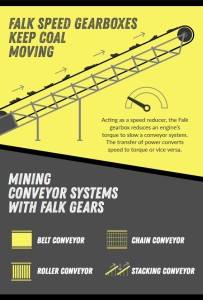Inching Drives Explained
Inching drives are units that provide slow-speed operation of conveyor or elevator systems in order to facilitate maintenance and inspection. An inching drive, which contains its own gearbox reducer to achieve the slower speeds, can be installed between the driving motor and the main drive system, or it can connect to the main drive system separately from the main motor.
Inching drives are also known as barring or auxiliary drives. In addition to conveyor and elevator applications, this unique type of Falk gear reducer can also be used for the following situations:
- Troubleshooting. An inching drive uses its gearbox reducer to move a system slowly through its operation at various stages, allowing problem areas to be investigated in detail.
- Maintenance. Slow operation allows for component inspection at various operating points and provides for dumping of conveyor contents, cleaning and repair of components, etc., at more convenient positions than might be available otherwise.
- Emergency operation. The inching drive can be used to move the system if the main drive fails, allowing a controlled shutdown until repairs can be made.
Components of an Inching Drive
The three main components of an inching drive system are the prime mover, a Falk gear reducer and a connecting element (clutch) that allows engagement when inching operation is required. The prime mover can be an electric motor or internal combustion engine. Electric motors are easily matched to the load requirements and require less maintenance. Internal combustion engines are used when operation is required but grid power is unavailable. For example, the conveyor in a mill or kiln must continue to operate when under heating conditions.
Three common inching drive configurations are concentric shaft, parallel shaft and right angle gearbox reducers. The simplest is the concentric shaft gearbox reducer, but it may require greater space between the motor and conveyor, which may necessitate a stronger support frame, additional space and custom parts.
Installation Considerations for Inching Drives
 Drive speed. The inching drive system must be chosen to provide the needed slow -speed operation. Motor speed and the total reduction of both the main and inching drives determine final drive speed.
Drive speed. The inching drive system must be chosen to provide the needed slow -speed operation. Motor speed and the total reduction of both the main and inching drives determine final drive speed.
 Drive power. The inching drive must be chosen to provide enough power to drive the system, generally under full load conditions. Operation is intermittent, so the service factor may be lower than for the main drive.
Drive power. The inching drive must be chosen to provide enough power to drive the system, generally under full load conditions. Operation is intermittent, so the service factor may be lower than for the main drive.
 Drive system. The Falk gear reducer and chain drives must be chosen to handle the total power resulting from motor power and the torque multiplication of the reduction units. Chains should be installed with the tension side up to prevent chain wrap on the driving sprocket.
Drive system. The Falk gear reducer and chain drives must be chosen to handle the total power resulting from motor power and the torque multiplication of the reduction units. Chains should be installed with the tension side up to prevent chain wrap on the driving sprocket.
 Coupling. Flexible or metallic element Falk couplings or fluid drives are commonly used. Fluid drives should be considered for their ability to absorb shock and allow for smaller drive motors.
Coupling. Flexible or metallic element Falk couplings or fluid drives are commonly used. Fluid drives should be considered for their ability to absorb shock and allow for smaller drive motors.
 Lubrication. The lubrication system must be able to provide sufficient oiling under both normal speed operation and inching drive operation. Additional oiling for inching drive system operation may be required.
Lubrication. The lubrication system must be able to provide sufficient oiling under both normal speed operation and inching drive operation. Additional oiling for inching drive system operation may be required.
Additional considerations include brakes to prevent unwanted system movement and a positive decoupling system with over-running clutch that prevents the inching drive from being engaged when the main drive is engaged. It’s also critical to select the right inching drive system and Falk couplings to complement the main drive system, ensuring that all components are properly matched to deliver the performance needed.
Mar-Dustrial is here to answer all of your questions about inching drives. Contact us at any time to ask your technical questions.
Posted under Machinery Maintenance, Products/Services on Thursday, September 29th, 2011

